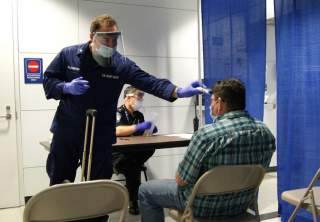Can the Lessons of SARS Help Stop Ebola?
"Basic public-health measures are the surest and most expedient way to respond to the current health emergency."
Ebola is raging out of control across three West African nations, threatening the security of those fragile states. To date, almost 5,000 people in West Africa have succumbed to Ebola and over 9,000 have been infected. Those numbers are predicted to double every three weeks unless drastic public-health measures are implemented. In the absence of a vaccine, effective medications and treatment, and surveillance that require a strong health system, quarantine may be the most effective measure for controlling this epidemic. The debate about quarantine is most active in the United States where it is used to back up other measures that are in place to detect the few infections that have entered the country. Meanwhile, the number of Ebola infections is rising unabated in West Africa as scientists debate the most efficacious biomedical response for the virus. Vaccines and pharmaceutical treatments are a good solution for preventing the next outbreak of Ebola, and several candidates are being considered. But we need only look back a little more than a decade, to the SARS pandemic, to see that basic public-health measures are the surest and most expedient way to respond to the current health emergency.
SARS initially spread out of control because of political mishaps and government cover-ups, ultimately infecting thousands and killing nearly 800 across the globe. International pressure convinced China to deal with the epidemic, but they, too, had a weak public-health system for detecting and treating infections. And, there was a worldwide shortage of the antiviral that could treat SARS. But China did an about-face after realizing the epidemic would result in huge economic and political damage, quickly building new hospitals dedicated to treating SARS patients, and instituting rigid quarantine measures that brought life in Beijing practically to a halt. The official weeklong Chinese May Day holiday that puts millions of people on planes, trains and buses during the first week of May was cancelled in 2003, keeping millions of travelers home. China installed fever-check stations in every transportation hub and venue for possible public gathering to limit the threat of transmission. The measures were extreme, but effective in bringing the first global pandemic of the twenty-first century under control only months after it began.
SARS taught China the value of getting ahead of epidemics to reduce their human and economic toll. Lessons learned were instituted during the subsequent H1N1 and H5N1 flu outbreaks through screening measures at China’s borders and contact tracing of anyone who developed a fever after arriving in China. Whole planeloads of international travelers were quarantined during these epidemics if even one passenger was discovered to have a fever. This may have helped prevent further spread of an epidemic that was predicted to reach historic proportions. It also demonstrated the importance of carefully considering an individual’s rights against the need to protect society.
Quarantine is a controversial measure, because historically, it has been employed in a way that induces stigma. But more recent examples demonstrate that quarantine can be employed in ways that allow public-health officials to balance individual rights and societal obligations. In the wake of Beijing’s faults, quarantine was the only measure available to prevent SARS from spiraling out of control. Quarantine also helped burn out an Ebola outbreak in Kikwit, Zaire during the summer of 1995.
The United States’ response to Ebola takes a page right from China’s experience with pandemic outbreak control. Travelers arriving from Ebola-affected countries are now screened for fever and tracked for twenty-one days. Several states are even trying to institute quarantine measures. These decisions have raised awareness of the epidemic and increased vigilance in our own public-health and medical systems. But vigilance should not stop at our borders.
China has historically proven the effectiveness of simple public-health measures that can bring a virulent epidemic under control. It is very likely, though, that SARS would not have been controlled without constant pressure from the WHO. Ebola has crippled several African nations and may impact several more. While we have fairly effectively controlled the epidemic within our own borders, it is time now to apply some of the lessons learned from China’s experience with SARS to West Africa to control the epidemic in the most affected areas. We know that basic public-health measures like screening and quarantine work. In the meantime, further development of biomedical measures against Ebola should continue in order to prepare for the next Ebola outbreak. Affected countries also need our long-term help to develop their health-systems infrastructure, including surveillance systems to keep future outbreaks at bay. By learning these important lessons from China’s experience with SARS, the United States may have a fighting chance at stopping the spread of Ebola.
Elanah Uretsky is an Assistant Professor of Global Health, Anthropology, and International Affairs at The George Washington University.
Amira Roess is a former Epidemic Intelligence Officer with expertise in outbreak investigations.

